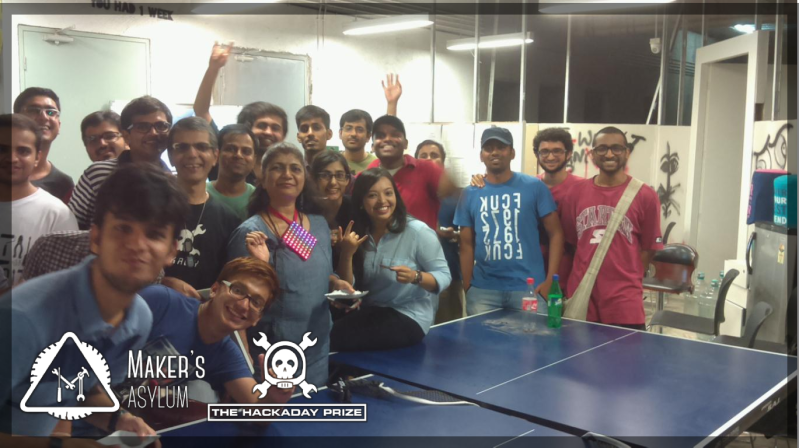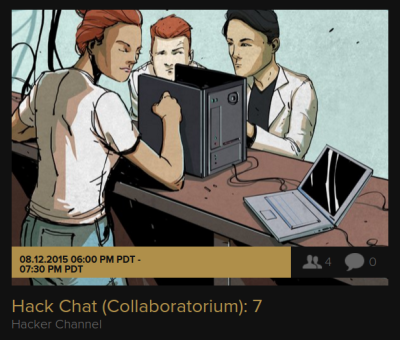This week we’ve covered the Grand Prize and Best Product winners of the 2015 Hackaday prize: Eyedrivomatic and Vinduino. These are both amazing and worthy projects, but the real story of the Hackaday Prize isn’t about the prizes: it’s about nine months during which talented people worked toward a common good.
If you didn’t have a chance to attend the Hackaday SuperConference, here is the video of the ceremony. Take a look at the presentation which was made in front of a packed house of about 300 attendees. Then join us after the break for a look back on the last nine amazing months.
Thank you to everyone who participated in the 2015 Hackaday Prize. Thinking about solving problems, using Open Design ideals to document and share ideas, and learning to work with one another in person or remotely has a profound effect on the world. These are the seeds for the breakthroughs of tomorrow. The next major accomplishment may come from someone who entered the Hackaday Prize, or a budding problem-solver following along in awe. Hackaday is proud to be a part of this movement of hackers, designers, artists, and engineers.
The Concept

This is the second year of the Hackaday Prize. Coming out of the 2014 Hackaday Prize we knew that people were excited about building with purpose. The 2014 Prize had a spectacular set of 50 finalists, and the Grand Prize winner, SatNOGS, told its own story of social good: making satellite data more widely available. And the SatNOGS project lives on. They formed a non-profit foundation and plowed the prize-winnings back into the project.
This example set by the SatNOGS team inspired us to look to 2015 for more social good. The purpose of the 2015 Hackaday Prize became: Build Something that Matters.
The Hackaday Community has the skills and capacity to improve lives all over the world. Hackers who are doing so should be recognized and rewarded. We tried to think of different grand prizes to be part of that reward; a submarine trip to the Marianas Trench, a trip to Antarctica to participate in a research mission, and a few other ideas were tossed around. But in the end, what’s bigger than a Trip to Space?
The Launch
![[Matt], [Sophi], and [Brian] building the Moisture Vaporator during the launch video](https://hackaday.com/wp-content/uploads/2015/11/screenshot-2015-11-19-at-10-58-43-am.png?w=400)
Making the video was an epic Hackaday journey. We met at the beginning of February for a couple of days to hammer out the Prize details. Spontaneously this turned into renting cameras, building a moisture vaporator prop, and spending one fun, sweaty day of filming. Take that, Hollywood!
The World Tour

Since the Hackaday Prize is as much about working together as winning prizes, the Hackaday Crew ran events all over the world during the competition. From hardware show-and-tells to workshops and hackathons, we had a fantastic time meeting the Hackaday Community in person. We called these events Hackaday Prize Worldwide and they took place in Chicago, Mumbai, Toronto, New York, Bangalore, Los Angeles, Shenzhen, New Delhi, Boston, Washington DC, Zurich, Berlin, and San Francisco.
In every event we tried to include lightning talks where people working on their Hackaday Prize entries could present their projects. Speaking publicly about your creations can cause you to think about them from your audience’s perspective, which can highlight those “unknown unknowns”. Rather than being one-way presentations, the attendees were often full of hacking knowledge. People who’d faced similar issues helped out and partnerships were formed. Sharing ideas brings hackers together.
The Hackaday Prize Worldwide tour, not to mention the $500,000 prize package, were made possible by the support of Supplyframe, who presented the 2015 Hackaday Prize, and the generous involvement of our sponsors: Atmel, Freescale, Microchip, Mouser, and Texas Instruments. Thank you for sharing our vision of making the world a better place through engineering and Open Design.
An Online Community
 The world tour was amazing, but not everyone was geographically near enough to an event to attend, so we formed the Hackaday Prize Channel. This live messaging system on Hackaday.io was mostly used for casual hangouts. But once a week we organized opportunities for people to present their projects in an online lightning talk.
The world tour was amazing, but not everyone was geographically near enough to an event to attend, so we formed the Hackaday Prize Channel. This live messaging system on Hackaday.io was mostly used for casual hangouts. But once a week we organized opportunities for people to present their projects in an online lightning talk.
We had as much fun as anyone during these online events — called the Collaboratorium. Looking back at it, many of the finalists were involved in those sessions. [Antti Lukats], creator of the DIPSY (Best Product Finalist), even co-hosted a session with Hackaday’s [Al Williams] specifically on programmable logic. The channel still exists, now called HackChat which which can be found on the Hacker Channel, and is a great place to hang out for a casual conversation or to ask some serious questions.
The Future
The 2015 Hackaday Prize was successful beyond measure. Just looking at the top two prize winners, Eyedrivomatic adds the freedom of mobility back to the lives of quadriplegics and Vinduino which helps make measuring crop irrigation simple and affordable, and enabls farmers to better conserve water. The potential reach of these two projects alone is astonishing, but they are among hundreds of worthy endeavors. If you want a hack that will benefit the world, we’ve got hundreds that you can borrow and build upon. If you’re inspired, the Hackaday Prize was a success.
The Hackaday Prize will ride again in 2016. It’s a bit too early to begin planning, but we’re always interested in hearing ideas. What do you think the challenge should be next year? Where do you want to see the Hackaday Prize go? Let us know in the comments below.























Firstly, great job to all the contestants.
Now, 2 years into this thing now…..
1) Is the Hackaday prize a good return on the investment? Did it actually bring in more readership (and revenue) than it cost to administer and the prize value?
2) What was the return this year vs last year? Increasing, decreasing, flat?
3) Are you guys really sticking with the “trip into space” thing? Anyone that would claim they would take that over the money is lying. Is it really that much better as a marketing thing?
4) How was the community involvement this year vs last year?
I’m not staff here, but lemme answer your questions from my point of view:
1. There are plenty of big name sponsors, so HaD isn’t footing the bill completely themselves. Just knowing some of the sponsors changed a few of my habits, like switching from Digikey to Mouser. All those entries had to generate at least some sales for parts and such.
2. Monetarily? Or in turnout of participants? I think this year was better because of increased coverage across the board as far as entrant turnout at least.
3. I’m a major space nut, and I have a decent job, so I might take the trip to space. There’s also a caveat to choosing the trip in the fine print of the rules: if they can’t deliver the trip to space in some reasonable amount of time (I think it was either 2 or 5 years) then you get $250k instead of just shy of $200k.
4. I feel the community involvement this year was much better, the project portion of the site has more users and is a better place to be in general compared to this time last year. I looked at all the entrants and followed and commented on my favorite entries a lot more than last year, and I received more positive feedback this year as well. The “Hacker Channel” hangouts were fun, I enjoyed giving and receiving feedback about the projects in the running.
Of course, these are just my sentiments. I entered last year and this year, so I have a good feel for it from the contestant side at least. I’d love to hear what any of the crew have to say though
I’m really happy you feel this way. I share many of the same views.
We had much more involvement this year and I’m very happy with the way everything went during the 2015 Hackaday Prize. Primarily the Prize is working to promote Open Design in engineering to show that learning these skills and achieving a high level of success is something anyone can do. It’s a matter of making the decision to try and then using all resources available — study online resource, reference the work of others, and most importantly to ask for help and mentorship. I love the Hacker Channel addition to this year’s effort. It’s a great place to go present your work and brainstorm or ask for help and collaboration.
“a trip to Antarctica to participate in a research mission,”
Woah! I could totally use a corporate-funded research assistant. :)
We were seriously looking into that and just couldn’t figure out all the details by the time we were announcing. But the thing I found really cool about the idea of participating in a research mission is that it’s both a life adventure and something that contributes to science. What I’m not sure about is the willingness of a serious research team to commit to an unknown (quite possibly untrained) person. But I still love the idea.
I say keep it consistent year after year (I mentioned security-focused some year, since…I want even more cool projects to build lol; and security can always get better), the massive prize money isn’t necessary but nice of course. B/c you’re not going to get many good finished products in what is realistically ~6 months, and that is free-time typically, so…that’s like 3-4 hours max each day if you work for a living, of not being on top of your game.
The good entries are things that people either specialize in or have worked on/studied for years.
Oh, right forgot…congrats everyone, cool projects! Good organization HaD team!
I liked this year’s prompt, but otherwise: robots.
This was a great event and I’m happy I took part in it. I blogged about this myself ( http://www.uradmonitor.com/the-hackaday-prize-2015/ ), and added a few more pics. Hackaday, thanks for your efforts, and hopefully you’ll continue what you have started.